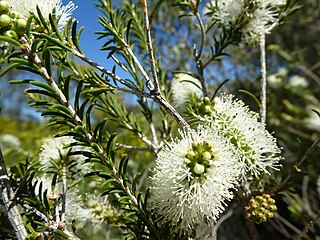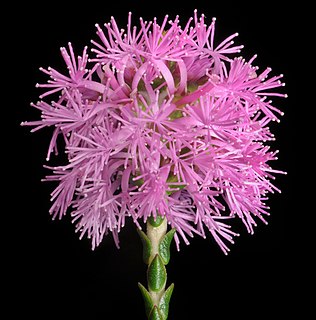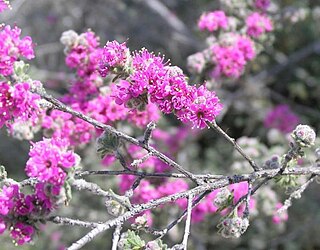
Eucalyptus preissiana, commonly known as bell-fruited mallee, is a species of small tree or shrub that occurs in an area between Albany and Esperance in Western Australia. It has a spreading habit, smooth bark, elliptical to egg-shaped or oblong leaves, flower buds in groups of three, yellow flowers and cup-shaped, conical or bell-shaped fruit.

Melaleuca rhaphiophylla, commonly known as swamp paperbark is a plant in the myrtle family, Myrtaceae and is endemic to the south west of Western Australia. It has narrow, needle-like leaves and profuse spikes of white or yellowish flowers at variable times throughout the year. As its common name suggests, it is usually found in salt marshes, or swamps or along watercourses and occurs over wide areas of the south-west.

Melaleuca squamophloia is a plant in the myrtle family, Myrtaceae and is endemic to the black soil plains of south eastern Queensland in Australia. Like its close relative Melaleuca styphelioides, it is a small, erect tree with prickly leaves and spikes of cream or white flowers but its bark is hard rather than papery and the leaves have fewer veins than that species.

Melaleuca stereophloia is a plant in the myrtle family, Myrtaceae and is endemic to the south west of Western Australia. It is similar to the broombush, Melaleuca uncinata with its needle-like leaves and heads of yellow to white flowers, but its back is hard and fibrous rather than papery.
Melaleuca arcana is a small tree or large shrub in the myrtle family, Myrtaceae and is endemic to Cape York Peninsula in northern Australia. It has papery bark and small heads of white flowers in summer.

Melaleuca violacea is a plant in the myrtle family Myrtaceae and is endemic to a small area in the south-west of Western Australia. It is a small, straggly, prostrate to semi-prostrate shrub with purple flowers and star-shaped fruit.

Melaleuca tuberculata is a small, variable shrub in the myrtle family Myrtaceae and is endemic to the south-west of Western Australia. There are three distinct varieties of this species, each with a different leaf size and shape, different distributions and somewhat different habitat preferences.

Melaleuca densa is a shrub in the myrtle family, Myrtaceae and is endemic to the south-west of Western Australia. It is a bushy shrub with profuse cream, yellow or greenish flowers and overlapping leaves on the youngest shoots.

Melaleuca holosericea is a plant in the myrtle family Myrtaceae which is endemic to the south-west of Western Australia. It is a small, rare shrub similar to other pink-flowered species in the Melaleuca scabra group.

Melaleuca micromera, commonly known as wattle honey-myrtle, is a plant in the myrtle family Myrtaceae and is endemic to a small area in the south-west of Western Australia. It is a rare species with unusual foliage and profuse small yellow flowerheads, making it a plant that is suitable for cultivation, if only to protect it from extinction.

Melaleuca parviceps, commonly known as rough honey-myrtle is a shrub in the myrtle family, Myrtaceae, and is endemic to the south-west of Western Australia. It is a shrub with varying shades of pink or purple flowers, the stamens tipped with yellow anthers. In describing it, John Lindley noted: "every twig ... is terminated by hemispherical heads of brilliant pink". It is similar to Melaleuca manglesii and Melaleuca seriata.

Melaleuca quadrifaria, commonly known as limestone honey-myrtle, is a plant in the myrtle family, Myrtaceae, and is native to the south of Western Australia. It is distinguished by the small size and arrangement of its leaves combined with its small spikes of white or cream flowers.
Melaleuca saligna is a shrub or tree in the myrtle family (Myrtaceae) and is endemic to the Cape York Peninsula in Queensland. It is a small tree with papery bark on the trunk, pendulous branches and white to greenish-yellow flowers between February and November. This species should not be confused with Callistemon salignus. If that species were to be moved to the genus Melaleuca, as proposed by some authors, its name would become Melaleuca salicina. Melaleuca saligna has its stamens arranged in bundles; the stamens of Callistemon salignus/Melaleuca salicina are all free.

Melaleuca sieberi is a shrub or tree in the myrtle, family Myrtaceae, which is endemic to coastal areas of New South Wales and Queensland. It is a large shrub or small tree with papery bark on the trunk, small, sharp leaves and small heads of fluffy flowers in spring. It should not be confused with Callistemon sieberi. When the callistemons were moved to Melaleuca, Callistemon sieberi became Melaleuca paludicola.

Melaleuca spathulata is a shrub in the myrtle family, Myrtaceae, and is endemic to the south-west of Western Australia. It is a well known garden shrub featuring dark green leaves against light-coloured foliage, many twisted branches and profuse heads of bright pink "pom pom" flower heads in spring or early summer.

Melaleuca suberosa, commonly known as corky-bark honey-myrtle or corky honeymyrtle, is a shrub in the myrtle family, Myrtaceae, and is endemic to the south of Western Australia. It is a distinctive shrub, recognised by its tiny, crowded leaves, corky bark and pink flowers that appear along lengths of leafless parts of the branches.

Melaleuca subtrigona is a plant in the myrtle family, Myrtaceae, and is endemic to the south-west of Western Australia. It is a small shrub with warty leaves and heads of "pom-pom" flowers in spring and early summer.

Melaleuca thyoides, commonly known as salt lake honey-myrtle is a plant in the myrtle family, Myrtaceae and is endemic to the south-west of Western Australia. It is an erect shrub with grey, papery or fibrous bark and very small, overlapping leaves on thin branchlets. It is a salt tolerant species often found on the edges of salt lakes.

Regelia inops is a plant in the myrtle family, Myrtaceae and is endemic to the south-west of Western Australia. It is an upright but often spreading shrub with tiny wedge shaped leaves and small heads of pink flowers on the ends of its branches in the warmer months.

Kunzea preissiana is a flowering plant in the myrtle family, Myrtaceae, and is endemic to the southwest of Western Australia. It is a shrub with hairy branches and leaves, pink to mauve flowers in groups on the ends of shoots, and twenty to thirty stamens about the same length as the petals. It is a widespread, often locally common species across its range.



















